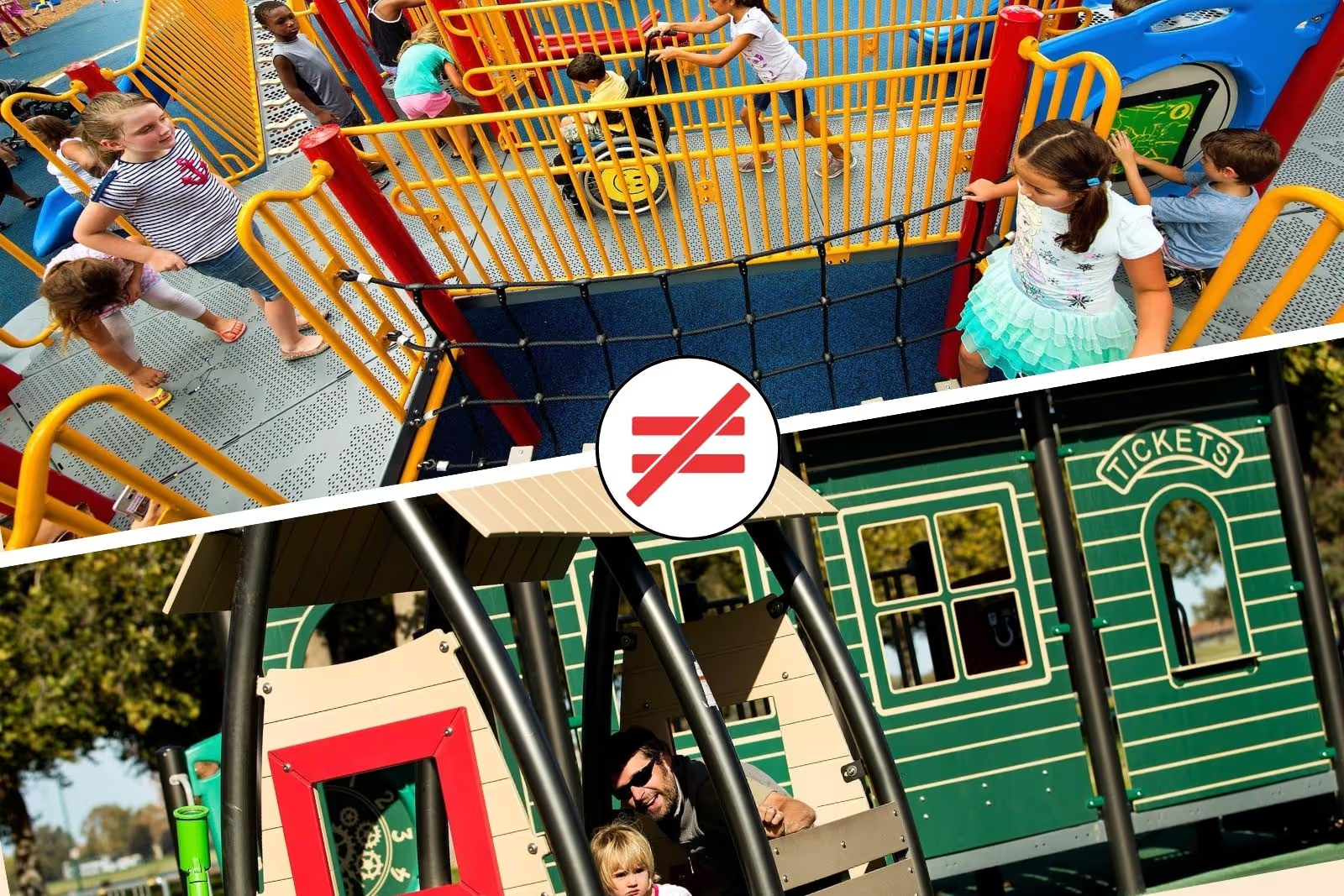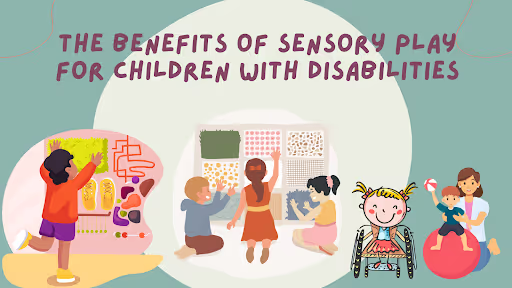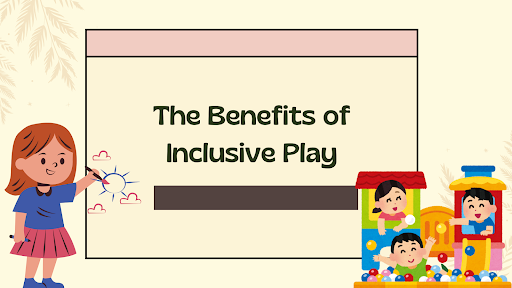How to Design an Inclusive Playground
Get a behind-the-scenes look at the research-based frameworks we use to design inclusive and accessible playgrounds for our clients, including the 7 Principles of Inclusive Playground Design and the 5 Domains of Child Development.


The Importance of Inclusive Playgrounds

In today’s world, the importance of inclusive playgrounds cannot be overstated. These spaces are more than just areas for children to play; they are environments where learning, growth, and socialization occur for people of all ages and abilities.
At Park N Play Design, we specialize in creating playgrounds that are not only accessible but also thoughtfully designed to foster meaningful play experiences for every child. We have certified inclusive design specialists and educators on staff to ensure we're using the latest research-based design practices when creating inclusive playgrounds.
One misconception that needs to be cleared up when it comes to inclusive playgrounds is that they're designed to cater to children with disabilities.

The reality is that inclusive playgrounds aren't designed just so that children with differing disabilities can have fun. Inclusive playgrounds provide opportunities for parallel play between children with differing abilities.
This is incredibly important for children as it helps reinforce that people of differing or reduced abilities are capable and deserving to be included in play opportunities. Inclusive playgrounds are just as important for children without disabilities as it helps remove any potential stigma associated with having a disability. The life-long overarching impact these playgrounds can have on children cannot be overstated.
The 7 Principles of Inclusive Playground Design is a research-based framework that offers a blueprint for designing inclusive spaces, ensuring that they are safe, engaging, and beneficial for all.
Canadian Standards Association (CSA): Playground Guidelines
Many of our clients ask us to design and build inclusive playgrounds. But what does an inclusive playground even look like? If we look to the latest Canadian standards for playgrounds (as outlined in the Canadian Standards Association (CSA) standard CAN/CSA-Z614, titled "Children’s Playspaces and Equipment.)" it doesn't tell us almost anything about what an inclusive playground is, let alone how to design one!
That's not to discredit the CSA standard. It's an extremely important ruleset for making sure the playgrounds we're building for our children are safe and properly maintained. The CSA standard covers things like:
- Playground Equipment: The standard sets out specific requirements for the design, installation, maintenance, and operation of playground equipment. This includes guidelines on materials, structural integrity, and the spacing of equipment to prevent overcrowding.
- Surfacing: Adequate surfacing is crucial for reducing the risk of injuries from falls. The standard specifies the type and depth of impact-absorbing surfaces required under and around playground equipment. Acceptable surfaces include materials like sand, pea gravel, wood chips, and engineered wood fiber, as well as synthetic options like rubber tiles and poured-in-place rubber.
- Fall Zones: The standard defines the necessary fall zones around playground equipment, which are areas where a child is likely to land if they fall. These zones must be free of obstacles and covered with impact-absorbing material.
- Accessibility: The CSA standard includes provisions for making playgrounds accessible to children with disabilities. This includes guidelines on ramp access, transfer platforms, and the use of ground-level play components.
- Maintenance and Inspections: Regular maintenance and inspections are required to ensure that playground equipment remains safe and functional. The standard outlines the frequency and type of inspections needed, as well as record-keeping practices.
- Signage: Playgrounds must have proper signage indicating the intended age group for the equipment, warnings of potential hazards, and any other relevant safety information.
- Installation: The standard also covers the installation procedures for playground equipment, ensuring that it is installed according to the manufacturer's specifications and in compliance with safety guidelines.
- Hazard Identification: The CSA Z614 standard provides a framework for identifying potential hazards in playgrounds, such as entanglement risks, sharp edges, and protrusions that could cause injury.

Where the Canadian Standards Association Playground Guidelines Fall Short: Inclusion
You'll notice that the CSA standards cover accessibility, but not inclusion. There is an important distinction between accessible playgrounds and inclusive playgrounds. An accessible playground may not always be inclusive, but an inclusive playground will always be accessible.
- The CSA standards for accessibility are what we consider the bare minimum. Providing ramp access, ground-level play components, and transfer platforms to individuals in mobility devices are great, but that doesn't make it an inclusive playground.
When we design an inclusive playground, we are intentionally designing and selecting equipment that is more usable by members of the community of all ages and abilities.

As we help plan and build these spaces, we ground our efforts in the 7 Principles of Inclusive Play, a guiding set of principles defined by our partner, PlayCore, and developed in partnership with leading play researchers. The 7 principles were created to help structure a standardized approach to building more truly inclusive play opportunities.
The 7 Principles of Inclusive Playground Design
1. Fairness in Play: Ensuring Equity for All
One of the core principles of inclusive playground design is fairness. This principle ensures that playgrounds offer equitable opportunities for all children, regardless of their physical or cognitive abilities. By integrating activities that cater to a wide range of developmental needs, these playgrounds promote social equity.
For schools, this means providing environments where every child can participate fully in play, which is critical for their overall development. At Park N Play Design, we understand the importance of fairness and work to ensure that every playground we design supports equal participation.
Address the needs of the whole child
Offer a variety of diverse play opportunities that intentionally address the physical, social-emotional, cognitive, sensory, and communicative developmental needs of the whole child to create a truly inclusive and embracing play experience.
- Incorporate equitable play activities across the developmental continuum at ground level and on the play structure that are unique.
Encourage multigenerational play
Select play activities that will provide developmentally meaningful experiences regardless of age and/or ability throughout the whole environment so that people of all ages can engage in play.
- Incorporate dynamic elements that are collaborative, fun, and address various developmental stages such as inclusive rocking components, musical instruments, front facing child to adult swings, interactive games, etc.

Program the space for inclusion
Use the play destination as a catalyst to promote structured and unstructured play activities between children with and without disabilities in an effort to create awareness, break down barriers, foster friendships, and address the benefits for the whole community.
- Host special events and intentionally program the play environment with activities that will help teach children about how they can successfully play together, educate them about similarities and differences, and support character development.
2. Inclusive Play: Bridging Gaps and Building Friendships
Inclusion is at the heart of every playground we design at Park N Play. The principle of inclusion focuses on providing diverse play options that cater to different abilities and preferences, allowing children of all abilities to play together.
For landscape architects, this means creating spaces where physical and social barriers are minimized, promoting interaction and understanding among all children. Municipalities benefit from inclusive designs as they foster stronger, more connected communities by ensuring that public spaces are welcoming to everyone.
Offer Various Types & Forms of Play
Organize the play environment to provide various types (physical, social, sensorimotor, construction, dramatic, etc.) and forms (autonomous, parallel, cooperative, etc.) of play so there is something exciting for everyone.
- Choose play activities that encourage children to play and cooperate together, use their imaginations, and demonstrate their creativity through dramatic play opportunities or incorporating relevant themes that support multiple users and/or side-by-side interaction

Ensure Variety & Graduated Levels of Challenge
Allow individuals to explore, interact, and engage in developmentally appropriate risk through a continuum of skills and movement experiences that are not typical to their daily routine.
- Provide a diverse assortment of play opportunities through swinging, sliding, spinning, rocking, crawling, climbing, brachiating/upper body bilateral coordination, and balancing.
- Encourage progression of physical skill development by incorporating play components that address the needs of beginning, intermediate, and advanced level players.
- Configure the layout to encourage active movement and exploration by offering balanced opportunities for social and physical play activities at both ground level and on the play structure.
Provide Choices
Offer choices in the method of participation and access of play activities throughout the play environment, particularly if there is no comparable alternative activity.
- Provide various ways to access the structure through climbers, links, transfer platforms, ramps, etc.
- Offer accommodations in both gross and fine motor activities so that all users can enjoy, manipulate, or interact at their own level.
3. Smart Design: Enhancing Understanding and Engagement
A playground designed with the principle of smart design ensures that the space is intuitive and easy to navigate for all users. This includes providing clear behavioural cues and sensory feedback that help children understand and engage with the environment.
For schools, this translates to environments where children can play and learn with minimal user conflict, enhancing their overall experience. At Park N Play Design, we prioritize smart design in all our projects, ensuring that every element of the playground contributes to a harmonious and engaging play experience.
Provide Behavioural Cues
Incorporate behavioural cues and sensory feedback to encourage communication, interaction, and positive reinforcement to help users understand what is expected.
- Strategically use colour, patterns, textures, accents, natural materials, and auditory, visual, and/or tactile supports to reinforce positive play behaviours, help visually organize activity areas so the environment is easy to understand, and naturally promote developmentally appropriate play behaviours.

Support Intuitive Play Patterns
Be consistent with individuals’ expectations, intuition, and naturally occurring developmental play behaviours, while avoiding unnecessary complexity.
- Incorporate “looping” patterns throughout the environment by intentionally designing slide exits near climbers, transfer points, and ramp entryways so that children can successfully engage in repetitive, active play to develop skills, build confidence, and stay engaged for longer periods of time.
Looping patterns are something you should look for in each playground design. It's usually one of the key differences between a generic cookie-cutter design vs. an intentionally designed play space.
Define Play Settings
Create a well-organized play environment with established, easy to recognize areas that intentionally reinforce appropriate play patterns and set clear expectations. Thoughtfully defined settings should allow children to remain immersed in play, expand on play opportunities, and avoid user conflict.
- Define active vs. passive play areas and organize these areas near other similar areas that can further enhance play experiences. For example, a dramatic play house could be positioned near a sand/water play area or by natural loose parts. Use of landscaping, color, or a variety of surfaces can create visual cues and help define areas.
- Define heavy/active use areas such as swings and slide exits to avoid user conflict and to indicate that play participants should use caution in high activity areas.
4. Independence: Empowering All Children
Independence is a key outcome of a well-designed inclusive playground. By offering accessible routes, universal signage, and features that support autonomy, children are empowered to play independently.
This is particularly important for children with disabilities, as it builds their confidence and self-esteem. At Park N Play Design, we incorporate these elements into our playgrounds, making sure that every child has the opportunity to explore and play on their own terms

Promote Diversity, Acceptance, & Mutual Respect
Promote character development and create a sense of community by considering people of diverse abilities, age, race, gender, ethnicity, culture, and socioeconomic status so that individuals can independently interact, participate, and enjoy playing together.
- Utilize universal signage with tailored messages, visual supports, Braille, sign language, sound, etc. to communicate expectations, encourage participation, and provide directional cues.
- Reinforce positive interactions between players by setting clear expectations or rules and/or offer unique play components/programming designed to create awareness and promote diversity.

Provide Accessible Surfacing & Routes of Travel
Create accessible routes of travel to and throughout the play environment so that everyone can engage in both physical and social play together.
- Use and maintain appropriate CSA compliant safety surfaces in play areas.
- Provide ramp access to accommodate multiple users, equipment, and caregivers.
- Utilize at least a 60 inch pathway and route of travel to and within the play environment.

Offer Sensory Rich Experiences
Encourage discovery and exploration through coherent multi-sensory experiences such as auditory (hearing), visual (seeing), tactile (touch), olfactory (smell), gustatory (taste), vestibular (balance and movement), and proprioceptive play (body position) to help children explore and understand the world around them.
- Select interactive play panels, music components, and/or manipulative activities that provide visual, tactile, and auditory feedback to increase understanding of cause and effect, promote learning, and create interaction between users.
- Provide organized multi-sensory experiences by creating a planned sensory environment incorporating manufactured and natural elements that use a variety of stimuli such as colour, light, pitch, tone, textures, movement, and smells. Avoid creating a chaotic sensory environment of haphazard stimuli.
- Offer sensory rich feedback and encourage participation through a variety of movement experiences such as swinging, sliding, rocking, and spinning to address vestibular and proprioceptive stimulation, while helping children develop a sense of balance and movement through space.

Encourage Independent Play
Provide opportunities for individuals using mobility devices, older adults, caregivers pushing strollers, people with service animals, and others to engage and access play as independently as possible. Caregivers or family members should be able to supervise and facilitate children’s participation in play when needed, without overly interfering.
- Incorporate universal design features such as slide transfers, transfer platforms, ramp access, adapted hand holds, etc. to support independence, while allowing individuals to build self-awareness, self-confidence, and self-esteem.

5. Safety First: Creating Secure Play Environments
Safety is a non-negotiable aspect of playground design. Inclusive playgrounds must meet rigorous safety standards while also providing areas where children can take healthy risks. This includes cozy spots for sensory relief, clear supervision areas, and age-appropriate equipment. For municipalities, ensuring the safety of playgrounds is essential for public trust and usage. Park N Play Design is committed to creating playgrounds that are not only fun but also safe and supportive environments for all children.
Apply Safety Standards and Address Potential Hazards
Provide age-appropriate play equipment that takes into consideration ongoing maintenance and sustainability.
- Age specific equipment should be clearly defined in designated areas with signage to clearly indicate the developmentally appropriate user groups.
- Handholds, barriers, and guardrails allow children to feel emotionally secure as they explore developmentally appropriate risk.
- Minimize the risk of children leaving the play area unsupervised, by considering the distance of the play environment from roads/parking areas, and when necessary utilizing manufactured or natural barriers such as fencing, land forms, or landscaping to create boundaries and barriers to traffic.
Integrate Emotional Well-Being
Support children’s feeling of emotional security so they are more likely to engage in play by incorporating cozy areas and “jump-in points” where children can retreat, observe, and integrate into play as they are emotionally ready to process the environment and engage in play.
- Cozy spots under decks, crawl tubes, tunnels, or seating strategically placed on the structure, below the structure, and around the environment offer places where children can seek sensory relief, engage in pretend play, or even play alone if desired.
- “Jump-in” points adjacent to or within activity areas offer convenient places for children to observe and understand play activity prior to participating. Active play areas should be designed to include natural “jump in points” so children are drawn into play as they are ready.

Accommodate for Comfortable Supervision
Thoughtfully lay out the environment for easy supervision and reduction of unintended hazards so caregivers and family members remain confident and secure while children are independently engaged in play.
- Offer shaded, accessible seating and supervision areas throughout the play environment with clear visibility of activity areas.

6. Active Play: Encouraging Physical and Social Engagement
The principle of activity ensures that playgrounds offer a balanced range of physical activities that cater to different abilities. This includes providing alternatives that allow all children to participate fully in physical play, whether through upper body activities or games that promote social cooperation. Schools and communities benefit greatly from these active play environments as they encourage physical fitness and social interaction. Park N Play Design’s playgrounds are designed to be vibrant hubs of activity, where every child can find something that challenges and excites them.
Accommodate Children's Diverse Physical Needs
Ensure that individuals have supports to maintain a neutral body position so they can sustain their engagement in active physical and social play.
- Accommodate children’s diverse physical characteristics and needs by including inclusive swinging, rocking, and/or spinning components that feature molded seats, high backs, and/or adjustable harnesses. These additional supports help children maintain a neutral body position, with low physical effort so they can fully enjoy powerful movement experiences.
Integrate Equitable Alternatives
Include diversity within play experiences by offering activities that require reasonable operating forces to sustain physical effort or repetitive actions.
- Provide equitable and diverse alternatives in close proximity to physical activities such as upper body/climbing equipment to offer rewarding fitness experiences designed to promote physical activity and encourage social interaction. Items such as therapeutic rings, hand cyclers, or chinning bars positioned adjacent to more advanced upper body activities provide a side-by-side upper body experience that addresses a wide variety of needs and skill levels.

Encourage Cooperation and Socialization
Integrate balanced play experiences that promote social inclusion through reciprocal and cooperative interaction between users throughout the play environment.
- Carefully select activities that encourage cooperation versus competition. Choose freestanding activities that work even better when two children are participating rather than competing with one another, such as inclusive whirls, tire or platform swings, see-saws, etc.

7. Comfort: Enhancing the Play Experience
Comfort is a crucial factor in ensuring that playgrounds are welcoming and accessible to all. This principle focuses on creating spaces that are comfortable to access and use, with features like ramps, ample shade, and appropriately sized play equipment. For landscape architects, incorporating these elements into a playground design ensures that the space is usable and enjoyable for everyone. At Park N Play Design, we always consider the comfort of all users, ensuring that our playgrounds provide a pleasant and engaging environment for extended play.
Address Approach & Reach Ranges
Provide play activities with comfortable approach and reach for individuals who are seated or standing.
- Offer half panels, balcony panels, or activities with adequate space underneath that allow individuals using a mobility device to approach and easily reach the play activity while facing forward.
- Install music activities, talk tubes, and other freestanding components at appropriate heights for the intended user’s age range to facilitate ease of use and enjoyment.

Provide Adequate Space for Movement & Gathering
Plan for multiple users, assistive devices/equipment, and/or personal assistance both on the structure and at ground level.
- Encourage multiple users to gather and move freely with ease throughout the play space by providing adequate space on decks, ramps, pathways, and accessible play components.
Offer a Balance of Environmental Conditions
Address the various needs of individuals by integrating a balance of exposure and relief to environmental conditions such as sunlight, shade, water, and wind.
- Utilize trees, integrated shade, or water areas for cooling to meet the needs and preferences of diverse users.
Plan for Amenities
Provide play activities with comfortable Offer amenities within comfortable proximity that will meet the various needs of users of all ages and abilities to enhance the user experience and promote interaction. and reach for individuals who are seated or standing.
- Provide amenities such as water fountains, restrooms, care amenities, and parking in close proximity to the play space that address the unique adaptive skills of everyone.
The Developmental Needs of the Whole Child

Inclusive playgrounds are vital in nurturing every aspect of a child’s development, especially for children with disabilities. These playgrounds are carefully designed to support growth across five key domains:
- Physical Development: Playgrounds offer various activities that help children develop gross and fine motor skills, improving their physical fitness and coordination.
- Social-Emotional Development: By encouraging group play and interaction, these spaces help children build relationships, learn empathy, and manage their emotions.
- Sensory Development: Inclusive playgrounds provide sensory-rich environments, catering to children who need different levels of sensory input, which is crucial for those with sensory processing challenges.
- Cognitive Development: Through problem-solving activities and play structures that require planning and strategy, children engage their cognitive abilities, fostering creativity and abstract thinking.
- Communication Development: These playgrounds are designed to promote social interaction and communication, encouraging children to develop their language skills and learn how to interact effectively with others.
Each of these domains is interconnected, making inclusive playgrounds essential for holistic child development, ensuring that every child can thrive, regardless of their abilities.
Bringing It All Together
Respecting the developmental needs of the whole child and thoughtfully applying the 7 Principles of Inclusive Playground Design® to outdoor play environments is a critical first step in offering high-quality spaces where both physical and social inclusion can occur.
These frameworks offer a unique design philosophy to help communities and professionals align evidence-based design considerations, intentionally select play activities that support inclusion, and advocate for outdoor play environments that move beyond the minimum accessibility standards to create truly meaningful universally designed play destinations.
This checklist is a great tool you can use to determine if you're covering all aspects of the 7 Principles of Inclusive Playground Design and the Developmental Needs of the Whole Child. This can be used to review an existing playground, or to review a design for a future playground.

If you'd like Park N Play Design's help in building a best-in-class inclusive playground, contact us to get started.
The best measure of an inclusive play destination’s success is how the community actually uses it. An in-depth review of the literature indicates that social intervention strategies positively impact the inclusion of children with disabilities in play activities with peers and is cited as a key strategy to promote social inclusion.
Disability awareness activities provide children the tools to ask questions, get accurate information, explore their feelings, and learn how to positively interact with their peers.
For an example of a project we designed using the 7 Principles of Inclusive Play, see our Brighton Core Case Study.

Curious how you can bring these principles into your new playground design or how to update an existing park to be more inclusive? We can help - let’s talk!












